Digital Forensics Reports: Analysis of IoT and Mobile Device Cases
VerifiedAdded on 2023/01/23
|25
|4299
|83
Report
AI Summary
This document comprises three distinct reports delving into the realm of digital forensics, specifically focusing on the challenges and advancements in investigating IoT and mobile devices. The first report examines the application of digital forensics in IoT and Wireless Sensor Networks (WSN), addressing the increasing security concerns and data processing complexities. It proposes a framework to reduce the data processing scope for forensic investigators by utilizing data selection algorithms. The second report introduces IoTDots, a digital forensic framework designed for IoT smart environments, emphasizing the limitations of current cloud-based architectures and advocating for an integrated approach to data recovery from core data sources. The final report concentrates on digital forensics in mobile devices, analyzing current and past trends, particularly in the context of Bring Your Own Device (BYOD) scenarios. It highlights the importance of mobile forensics (MF) and proposes a framework encompassing data acquisition, malware analysis, evidence reconstruction, and behavioral analysis to enhance investigation efficiency. All three reports underscore the need for improved security frameworks and automated data selection processes to streamline forensic investigations and ensure the admissibility of evidence in legal proceedings. Future work includes the automation of data selection and practical exploration of integrating proposed frameworks into smart environments.
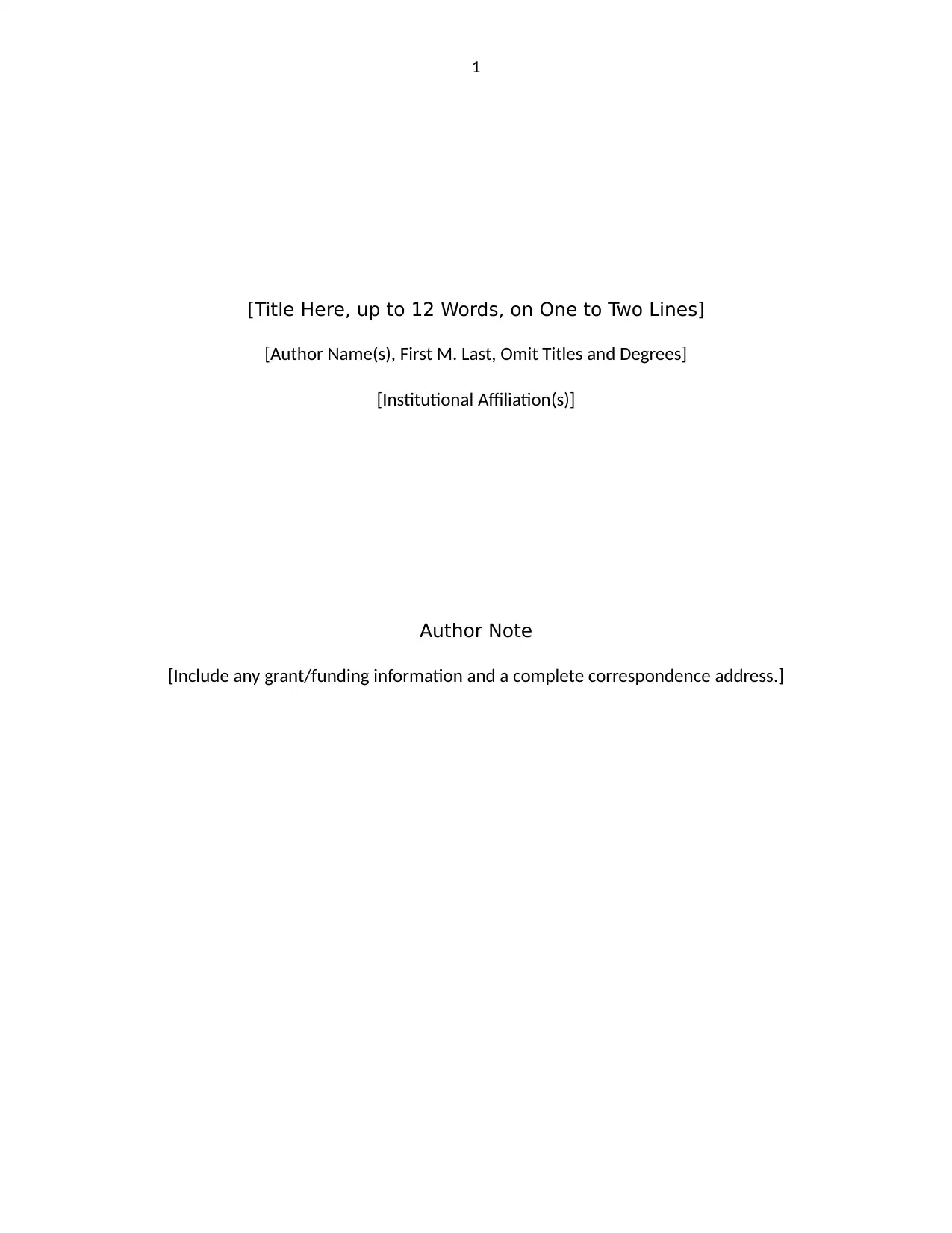
1
[Title Here, up to 12 Words, on One to Two Lines]
[Author Name(s), First M. Last, Omit Titles and Degrees]
[Institutional Affiliation(s)]
Author Note
[Include any grant/funding information and a complete correspondence address.]
[Title Here, up to 12 Words, on One to Two Lines]
[Author Name(s), First M. Last, Omit Titles and Degrees]
[Institutional Affiliation(s)]
Author Note
[Include any grant/funding information and a complete correspondence address.]
Paraphrase This Document
Need a fresh take? Get an instant paraphrase of this document with our AI Paraphraser
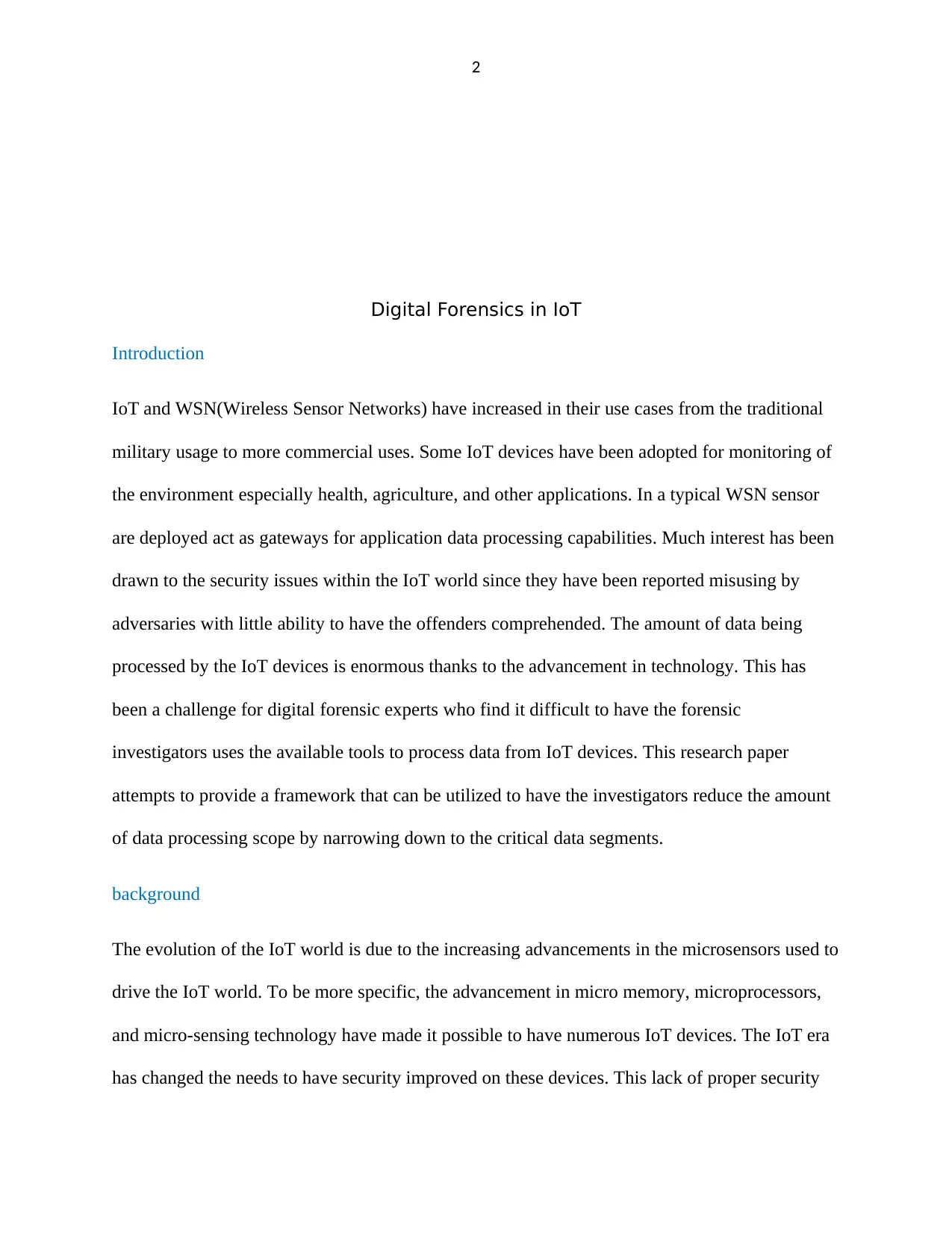
2
Digital Forensics in IoT
Introduction
IoT and WSN(Wireless Sensor Networks) have increased in their use cases from the traditional
military usage to more commercial uses. Some IoT devices have been adopted for monitoring of
the environment especially health, agriculture, and other applications. In a typical WSN sensor
are deployed act as gateways for application data processing capabilities. Much interest has been
drawn to the security issues within the IoT world since they have been reported misusing by
adversaries with little ability to have the offenders comprehended. The amount of data being
processed by the IoT devices is enormous thanks to the advancement in technology. This has
been a challenge for digital forensic experts who find it difficult to have the forensic
investigators uses the available tools to process data from IoT devices. This research paper
attempts to provide a framework that can be utilized to have the investigators reduce the amount
of data processing scope by narrowing down to the critical data segments.
background
The evolution of the IoT world is due to the increasing advancements in the microsensors used to
drive the IoT world. To be more specific, the advancement in micro memory, microprocessors,
and micro-sensing technology have made it possible to have numerous IoT devices. The IoT era
has changed the needs to have security improved on these devices. This lack of proper security
Digital Forensics in IoT
Introduction
IoT and WSN(Wireless Sensor Networks) have increased in their use cases from the traditional
military usage to more commercial uses. Some IoT devices have been adopted for monitoring of
the environment especially health, agriculture, and other applications. In a typical WSN sensor
are deployed act as gateways for application data processing capabilities. Much interest has been
drawn to the security issues within the IoT world since they have been reported misusing by
adversaries with little ability to have the offenders comprehended. The amount of data being
processed by the IoT devices is enormous thanks to the advancement in technology. This has
been a challenge for digital forensic experts who find it difficult to have the forensic
investigators uses the available tools to process data from IoT devices. This research paper
attempts to provide a framework that can be utilized to have the investigators reduce the amount
of data processing scope by narrowing down to the critical data segments.
background
The evolution of the IoT world is due to the increasing advancements in the microsensors used to
drive the IoT world. To be more specific, the advancement in micro memory, microprocessors,
and micro-sensing technology have made it possible to have numerous IoT devices. The IoT era
has changed the needs to have security improved on these devices. This lack of proper security
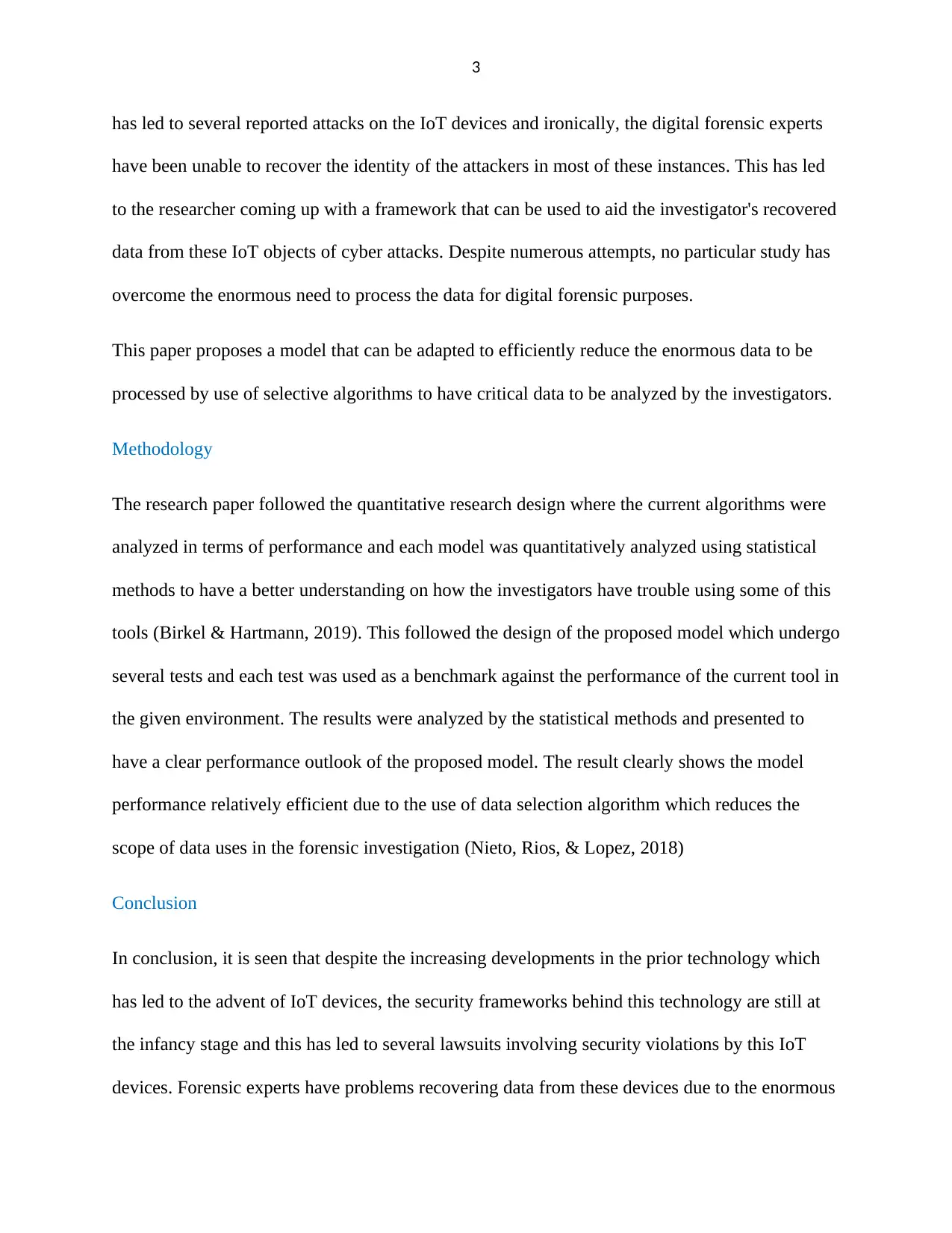
3
has led to several reported attacks on the IoT devices and ironically, the digital forensic experts
have been unable to recover the identity of the attackers in most of these instances. This has led
to the researcher coming up with a framework that can be used to aid the investigator's recovered
data from these IoT objects of cyber attacks. Despite numerous attempts, no particular study has
overcome the enormous need to process the data for digital forensic purposes.
This paper proposes a model that can be adapted to efficiently reduce the enormous data to be
processed by use of selective algorithms to have critical data to be analyzed by the investigators.
Methodology
The research paper followed the quantitative research design where the current algorithms were
analyzed in terms of performance and each model was quantitatively analyzed using statistical
methods to have a better understanding on how the investigators have trouble using some of this
tools (Birkel & Hartmann, 2019). This followed the design of the proposed model which undergo
several tests and each test was used as a benchmark against the performance of the current tool in
the given environment. The results were analyzed by the statistical methods and presented to
have a clear performance outlook of the proposed model. The result clearly shows the model
performance relatively efficient due to the use of data selection algorithm which reduces the
scope of data uses in the forensic investigation (Nieto, Rios, & Lopez, 2018)
Conclusion
In conclusion, it is seen that despite the increasing developments in the prior technology which
has led to the advent of IoT devices, the security frameworks behind this technology are still at
the infancy stage and this has led to several lawsuits involving security violations by this IoT
devices. Forensic experts have problems recovering data from these devices due to the enormous
has led to several reported attacks on the IoT devices and ironically, the digital forensic experts
have been unable to recover the identity of the attackers in most of these instances. This has led
to the researcher coming up with a framework that can be used to aid the investigator's recovered
data from these IoT objects of cyber attacks. Despite numerous attempts, no particular study has
overcome the enormous need to process the data for digital forensic purposes.
This paper proposes a model that can be adapted to efficiently reduce the enormous data to be
processed by use of selective algorithms to have critical data to be analyzed by the investigators.
Methodology
The research paper followed the quantitative research design where the current algorithms were
analyzed in terms of performance and each model was quantitatively analyzed using statistical
methods to have a better understanding on how the investigators have trouble using some of this
tools (Birkel & Hartmann, 2019). This followed the design of the proposed model which undergo
several tests and each test was used as a benchmark against the performance of the current tool in
the given environment. The results were analyzed by the statistical methods and presented to
have a clear performance outlook of the proposed model. The result clearly shows the model
performance relatively efficient due to the use of data selection algorithm which reduces the
scope of data uses in the forensic investigation (Nieto, Rios, & Lopez, 2018)
Conclusion
In conclusion, it is seen that despite the increasing developments in the prior technology which
has led to the advent of IoT devices, the security frameworks behind this technology are still at
the infancy stage and this has led to several lawsuits involving security violations by this IoT
devices. Forensic experts have problems recovering data from these devices due to the enormous
⊘ This is a preview!⊘
Do you want full access?
Subscribe today to unlock all pages.

Trusted by 1+ million students worldwide

4
data being processed by these sensors hence making it inefficient to reliable rely on the outcome
hence not easily admissible in lawsuits. The research has proposed a better model that can
leverage on the data selection algorithm which reduces the scope of data to be processed by the
forensic tools increasing efficiency exponentially
Future works
Future enhancement onto the work included the automation of the selection processed of the IoT
devices. This provides a more efficient approach to improving the working of the algorithm
data being processed by these sensors hence making it inefficient to reliable rely on the outcome
hence not easily admissible in lawsuits. The research has proposed a better model that can
leverage on the data selection algorithm which reduces the scope of data to be processed by the
forensic tools increasing efficiency exponentially
Future works
Future enhancement onto the work included the automation of the selection processed of the IoT
devices. This provides a more efficient approach to improving the working of the algorithm
Paraphrase This Document
Need a fresh take? Get an instant paraphrase of this document with our AI Paraphraser

5
[Title Here, up to 12 Words, on One to Two Lines]
[Author Name(s), First M. Last, Omit Titles and Degrees]
[Institutional Affiliation(s)]
Author Note
[Include any grant/funding information and a complete correspondence address.]
[Title Here, up to 12 Words, on One to Two Lines]
[Author Name(s), First M. Last, Omit Titles and Degrees]
[Institutional Affiliation(s)]
Author Note
[Include any grant/funding information and a complete correspondence address.]
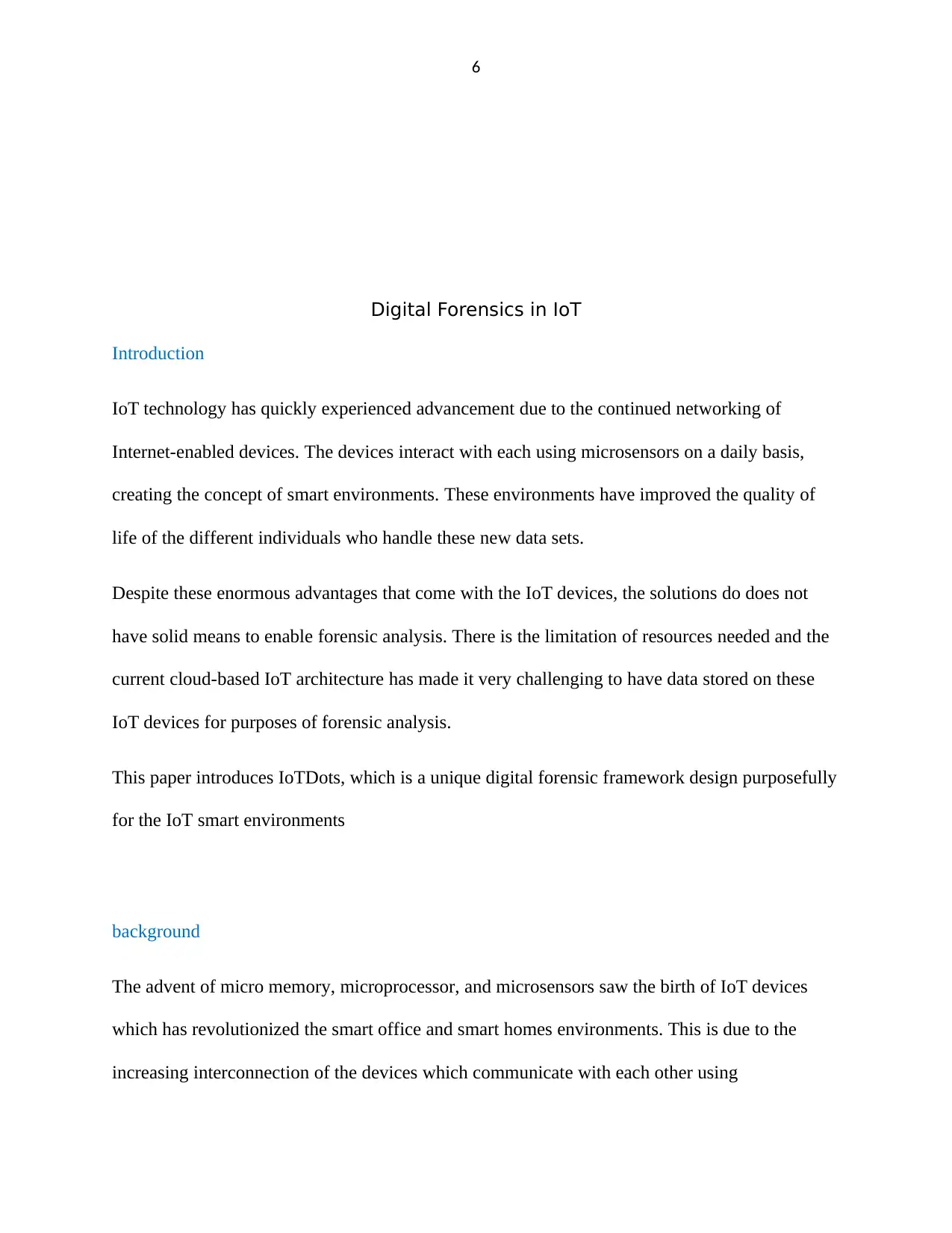
6
Digital Forensics in IoT
Introduction
IoT technology has quickly experienced advancement due to the continued networking of
Internet-enabled devices. The devices interact with each using microsensors on a daily basis,
creating the concept of smart environments. These environments have improved the quality of
life of the different individuals who handle these new data sets.
Despite these enormous advantages that come with the IoT devices, the solutions do does not
have solid means to enable forensic analysis. There is the limitation of resources needed and the
current cloud-based IoT architecture has made it very challenging to have data stored on these
IoT devices for purposes of forensic analysis.
This paper introduces IoTDots, which is a unique digital forensic framework design purposefully
for the IoT smart environments
background
The advent of micro memory, microprocessor, and microsensors saw the birth of IoT devices
which has revolutionized the smart office and smart homes environments. This is due to the
increasing interconnection of the devices which communicate with each other using
Digital Forensics in IoT
Introduction
IoT technology has quickly experienced advancement due to the continued networking of
Internet-enabled devices. The devices interact with each using microsensors on a daily basis,
creating the concept of smart environments. These environments have improved the quality of
life of the different individuals who handle these new data sets.
Despite these enormous advantages that come with the IoT devices, the solutions do does not
have solid means to enable forensic analysis. There is the limitation of resources needed and the
current cloud-based IoT architecture has made it very challenging to have data stored on these
IoT devices for purposes of forensic analysis.
This paper introduces IoTDots, which is a unique digital forensic framework design purposefully
for the IoT smart environments
background
The advent of micro memory, microprocessor, and microsensors saw the birth of IoT devices
which has revolutionized the smart office and smart homes environments. This is due to the
increasing interconnection of the devices which communicate with each other using
⊘ This is a preview!⊘
Do you want full access?
Subscribe today to unlock all pages.

Trusted by 1+ million students worldwide
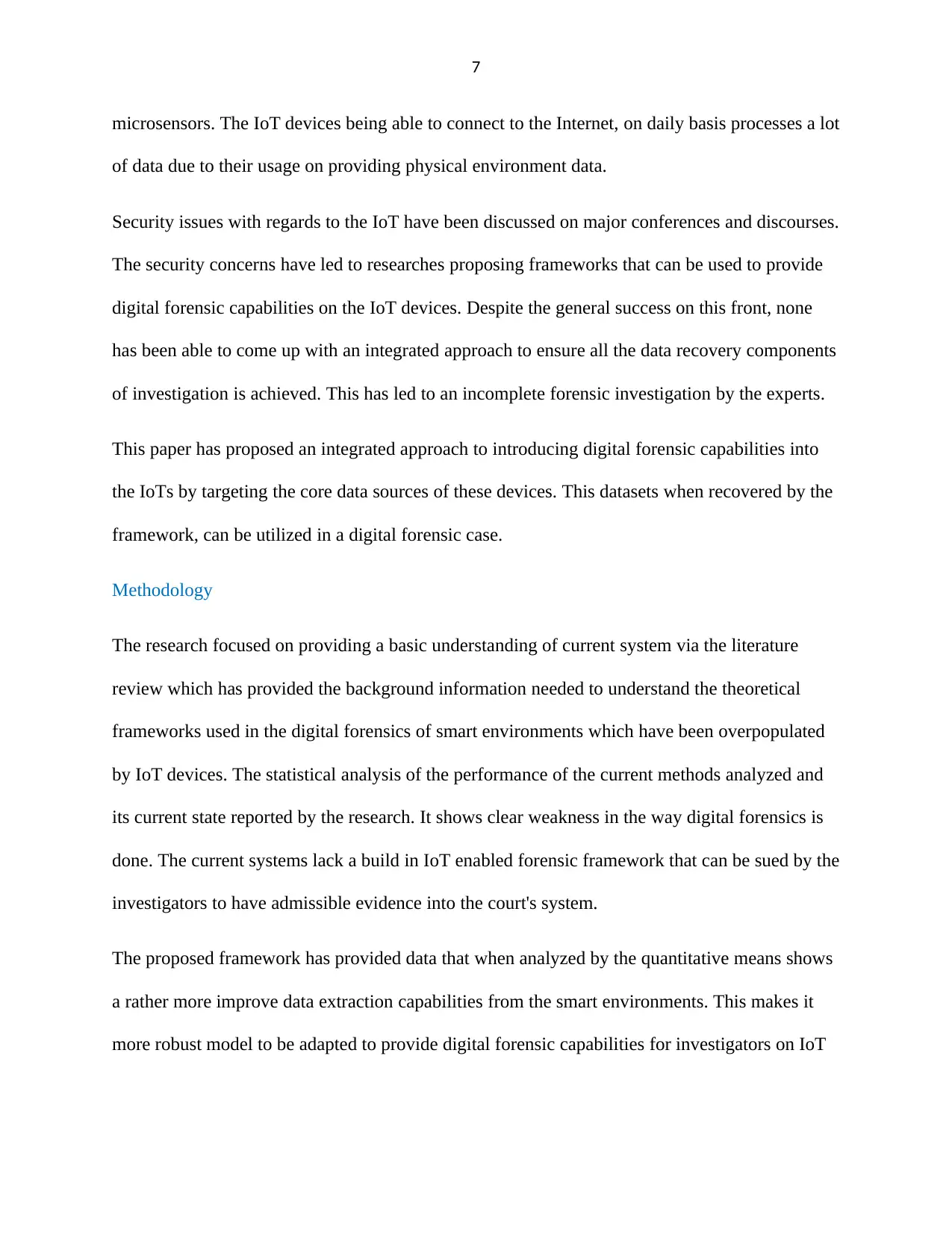
7
microsensors. The IoT devices being able to connect to the Internet, on daily basis processes a lot
of data due to their usage on providing physical environment data.
Security issues with regards to the IoT have been discussed on major conferences and discourses.
The security concerns have led to researches proposing frameworks that can be used to provide
digital forensic capabilities on the IoT devices. Despite the general success on this front, none
has been able to come up with an integrated approach to ensure all the data recovery components
of investigation is achieved. This has led to an incomplete forensic investigation by the experts.
This paper has proposed an integrated approach to introducing digital forensic capabilities into
the IoTs by targeting the core data sources of these devices. This datasets when recovered by the
framework, can be utilized in a digital forensic case.
Methodology
The research focused on providing a basic understanding of current system via the literature
review which has provided the background information needed to understand the theoretical
frameworks used in the digital forensics of smart environments which have been overpopulated
by IoT devices. The statistical analysis of the performance of the current methods analyzed and
its current state reported by the research. It shows clear weakness in the way digital forensics is
done. The current systems lack a build in IoT enabled forensic framework that can be sued by the
investigators to have admissible evidence into the court's system.
The proposed framework has provided data that when analyzed by the quantitative means shows
a rather more improve data extraction capabilities from the smart environments. This makes it
more robust model to be adapted to provide digital forensic capabilities for investigators on IoT
microsensors. The IoT devices being able to connect to the Internet, on daily basis processes a lot
of data due to their usage on providing physical environment data.
Security issues with regards to the IoT have been discussed on major conferences and discourses.
The security concerns have led to researches proposing frameworks that can be used to provide
digital forensic capabilities on the IoT devices. Despite the general success on this front, none
has been able to come up with an integrated approach to ensure all the data recovery components
of investigation is achieved. This has led to an incomplete forensic investigation by the experts.
This paper has proposed an integrated approach to introducing digital forensic capabilities into
the IoTs by targeting the core data sources of these devices. This datasets when recovered by the
framework, can be utilized in a digital forensic case.
Methodology
The research focused on providing a basic understanding of current system via the literature
review which has provided the background information needed to understand the theoretical
frameworks used in the digital forensics of smart environments which have been overpopulated
by IoT devices. The statistical analysis of the performance of the current methods analyzed and
its current state reported by the research. It shows clear weakness in the way digital forensics is
done. The current systems lack a build in IoT enabled forensic framework that can be sued by the
investigators to have admissible evidence into the court's system.
The proposed framework has provided data that when analyzed by the quantitative means shows
a rather more improve data extraction capabilities from the smart environments. This makes it
more robust model to be adapted to provide digital forensic capabilities for investigators on IoT
Paraphrase This Document
Need a fresh take? Get an instant paraphrase of this document with our AI Paraphraser
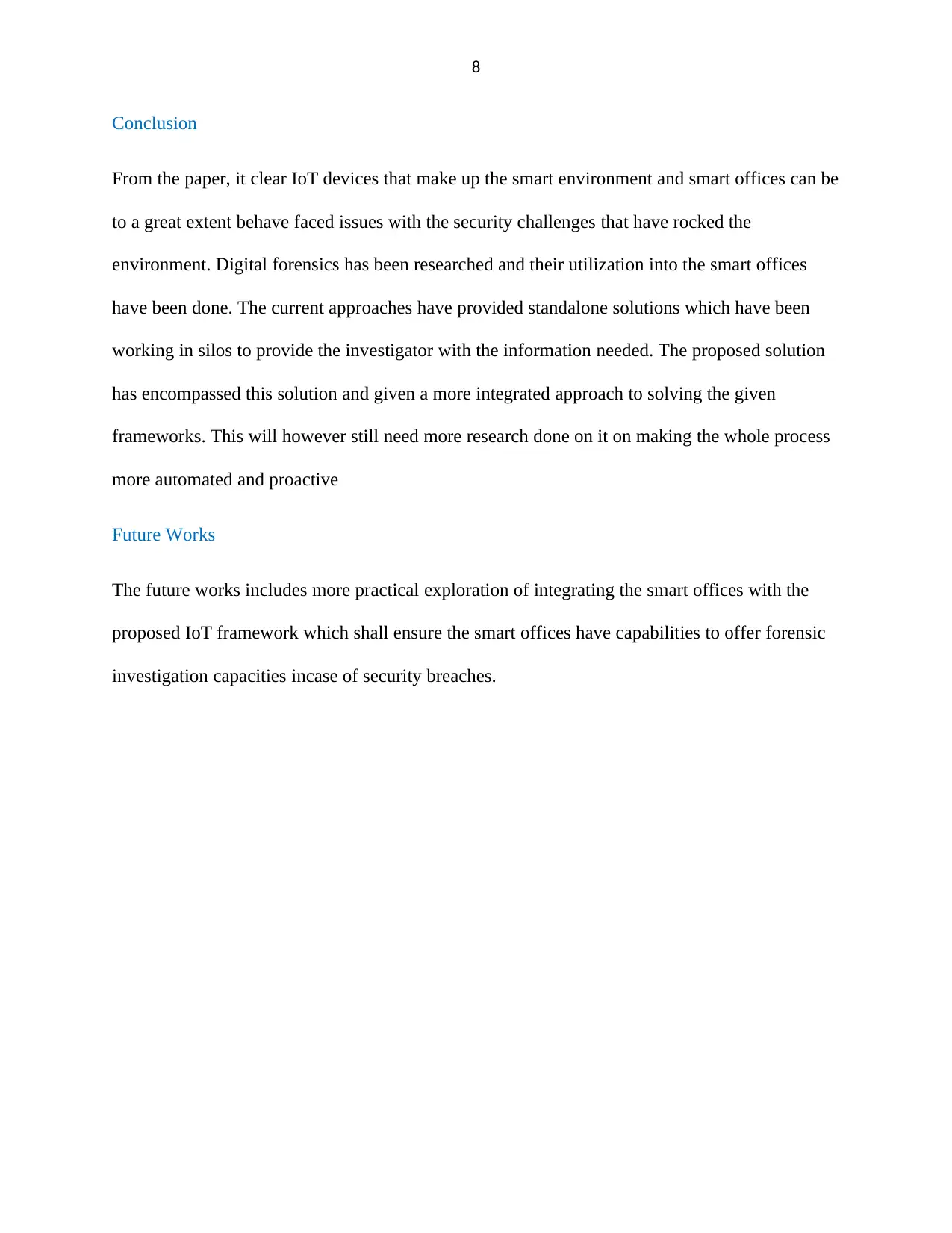
8
Conclusion
From the paper, it clear IoT devices that make up the smart environment and smart offices can be
to a great extent behave faced issues with the security challenges that have rocked the
environment. Digital forensics has been researched and their utilization into the smart offices
have been done. The current approaches have provided standalone solutions which have been
working in silos to provide the investigator with the information needed. The proposed solution
has encompassed this solution and given a more integrated approach to solving the given
frameworks. This will however still need more research done on it on making the whole process
more automated and proactive
Future Works
The future works includes more practical exploration of integrating the smart offices with the
proposed IoT framework which shall ensure the smart offices have capabilities to offer forensic
investigation capacities incase of security breaches.
Conclusion
From the paper, it clear IoT devices that make up the smart environment and smart offices can be
to a great extent behave faced issues with the security challenges that have rocked the
environment. Digital forensics has been researched and their utilization into the smart offices
have been done. The current approaches have provided standalone solutions which have been
working in silos to provide the investigator with the information needed. The proposed solution
has encompassed this solution and given a more integrated approach to solving the given
frameworks. This will however still need more research done on it on making the whole process
more automated and proactive
Future Works
The future works includes more practical exploration of integrating the smart offices with the
proposed IoT framework which shall ensure the smart offices have capabilities to offer forensic
investigation capacities incase of security breaches.

9
[Title Here, up to 12 Words, on One to Two Lines]
[Author Name(s), First M. Last, Omit Titles and Degrees]
[Institutional Affiliation(s)]
Author Note
[Include any grant/funding information and a complete correspondence address.]
[Title Here, up to 12 Words, on One to Two Lines]
[Author Name(s), First M. Last, Omit Titles and Degrees]
[Institutional Affiliation(s)]
Author Note
[Include any grant/funding information and a complete correspondence address.]
⊘ This is a preview!⊘
Do you want full access?
Subscribe today to unlock all pages.

Trusted by 1+ million students worldwide
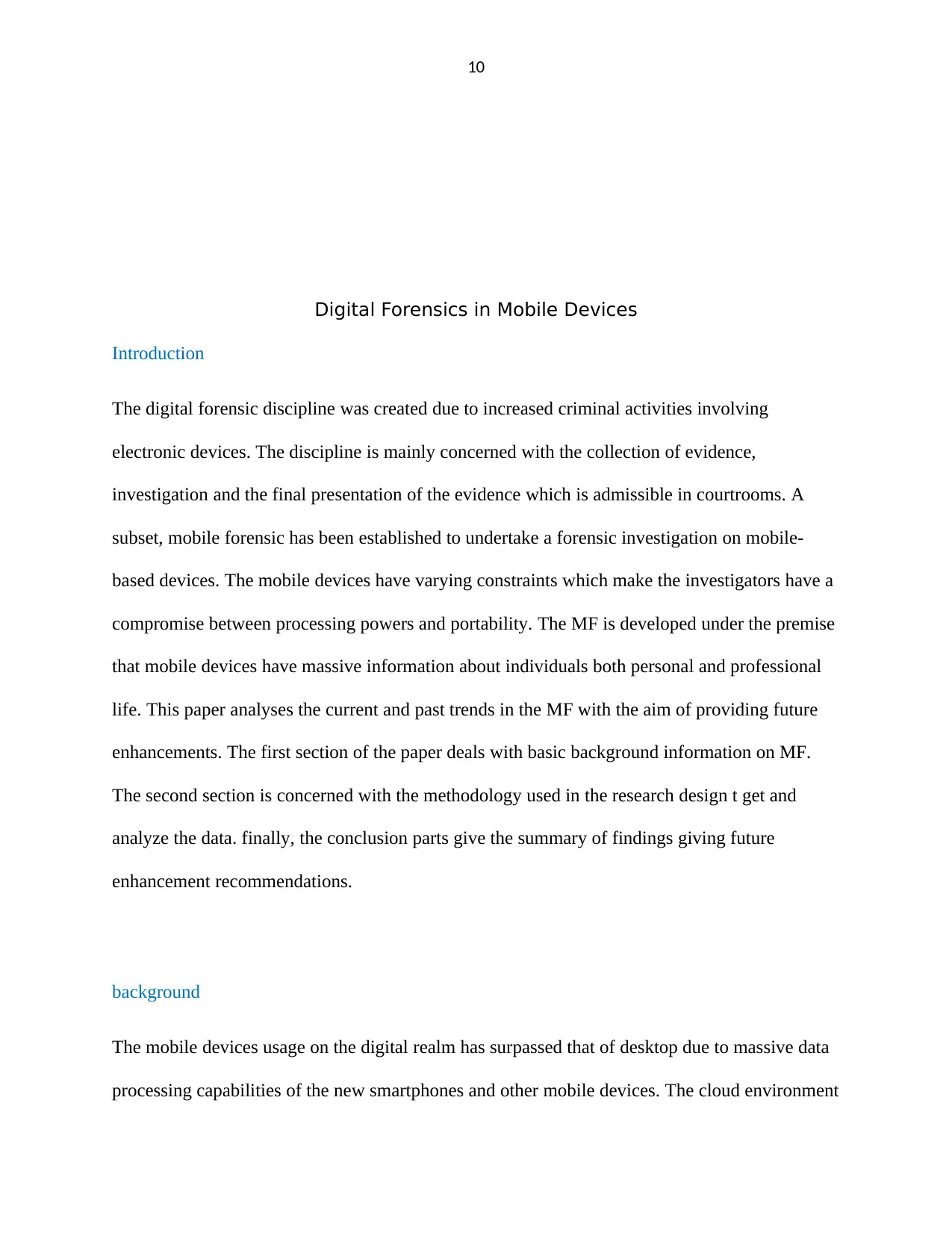
10
Digital Forensics in Mobile Devices
Introduction
The digital forensic discipline was created due to increased criminal activities involving
electronic devices. The discipline is mainly concerned with the collection of evidence,
investigation and the final presentation of the evidence which is admissible in courtrooms. A
subset, mobile forensic has been established to undertake a forensic investigation on mobile-
based devices. The mobile devices have varying constraints which make the investigators have a
compromise between processing powers and portability. The MF is developed under the premise
that mobile devices have massive information about individuals both personal and professional
life. This paper analyses the current and past trends in the MF with the aim of providing future
enhancements. The first section of the paper deals with basic background information on MF.
The second section is concerned with the methodology used in the research design t get and
analyze the data. finally, the conclusion parts give the summary of findings giving future
enhancement recommendations.
background
The mobile devices usage on the digital realm has surpassed that of desktop due to massive data
processing capabilities of the new smartphones and other mobile devices. The cloud environment
Digital Forensics in Mobile Devices
Introduction
The digital forensic discipline was created due to increased criminal activities involving
electronic devices. The discipline is mainly concerned with the collection of evidence,
investigation and the final presentation of the evidence which is admissible in courtrooms. A
subset, mobile forensic has been established to undertake a forensic investigation on mobile-
based devices. The mobile devices have varying constraints which make the investigators have a
compromise between processing powers and portability. The MF is developed under the premise
that mobile devices have massive information about individuals both personal and professional
life. This paper analyses the current and past trends in the MF with the aim of providing future
enhancements. The first section of the paper deals with basic background information on MF.
The second section is concerned with the methodology used in the research design t get and
analyze the data. finally, the conclusion parts give the summary of findings giving future
enhancement recommendations.
background
The mobile devices usage on the digital realm has surpassed that of desktop due to massive data
processing capabilities of the new smartphones and other mobile devices. The cloud environment
Paraphrase This Document
Need a fresh take? Get an instant paraphrase of this document with our AI Paraphraser
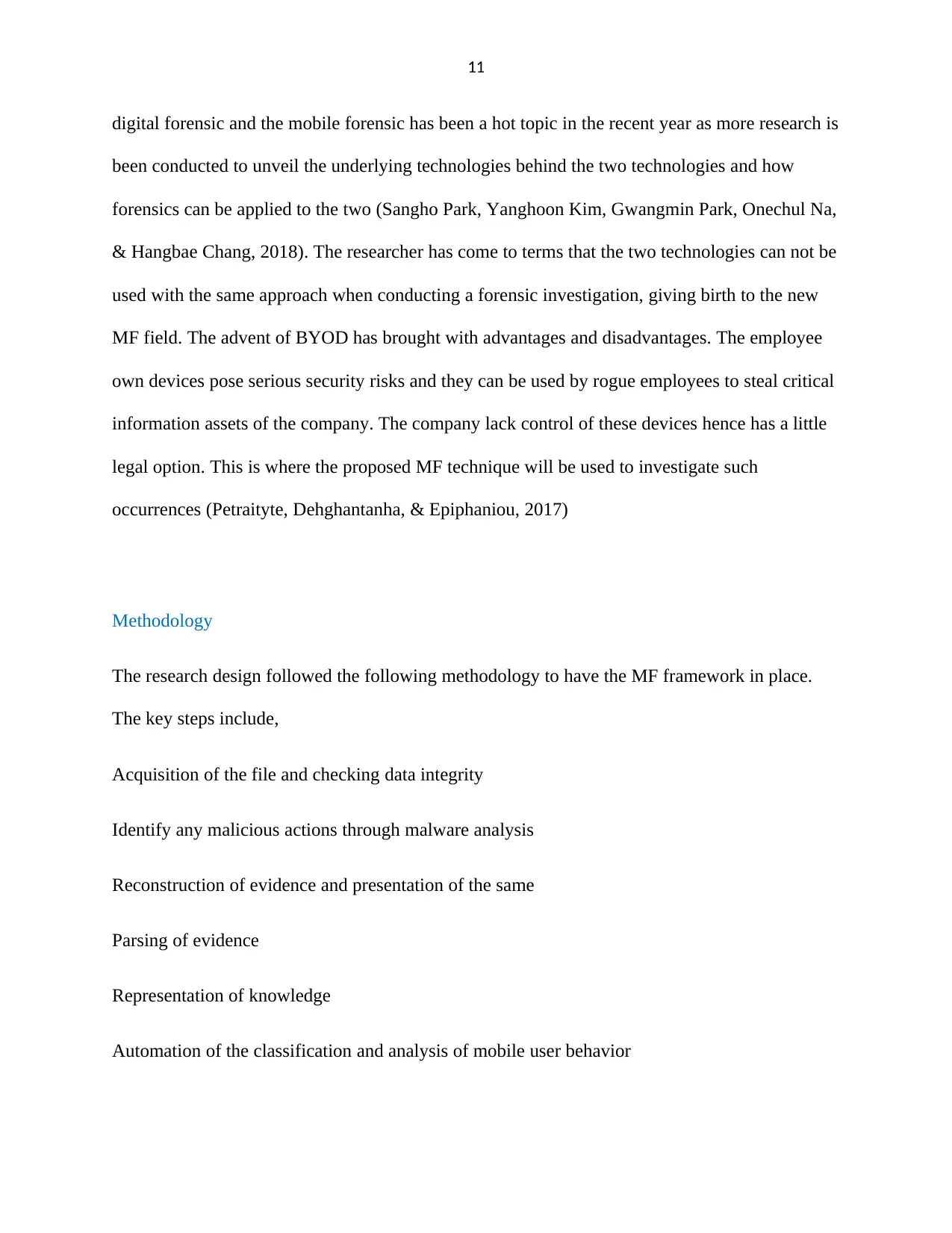
11
digital forensic and the mobile forensic has been a hot topic in the recent year as more research is
been conducted to unveil the underlying technologies behind the two technologies and how
forensics can be applied to the two (Sangho Park, Yanghoon Kim, Gwangmin Park, Onechul Na,
& Hangbae Chang, 2018). The researcher has come to terms that the two technologies can not be
used with the same approach when conducting a forensic investigation, giving birth to the new
MF field. The advent of BYOD has brought with advantages and disadvantages. The employee
own devices pose serious security risks and they can be used by rogue employees to steal critical
information assets of the company. The company lack control of these devices hence has a little
legal option. This is where the proposed MF technique will be used to investigate such
occurrences (Petraityte, Dehghantanha, & Epiphaniou, 2017)
Methodology
The research design followed the following methodology to have the MF framework in place.
The key steps include,
Acquisition of the file and checking data integrity
Identify any malicious actions through malware analysis
Reconstruction of evidence and presentation of the same
Parsing of evidence
Representation of knowledge
Automation of the classification and analysis of mobile user behavior
digital forensic and the mobile forensic has been a hot topic in the recent year as more research is
been conducted to unveil the underlying technologies behind the two technologies and how
forensics can be applied to the two (Sangho Park, Yanghoon Kim, Gwangmin Park, Onechul Na,
& Hangbae Chang, 2018). The researcher has come to terms that the two technologies can not be
used with the same approach when conducting a forensic investigation, giving birth to the new
MF field. The advent of BYOD has brought with advantages and disadvantages. The employee
own devices pose serious security risks and they can be used by rogue employees to steal critical
information assets of the company. The company lack control of these devices hence has a little
legal option. This is where the proposed MF technique will be used to investigate such
occurrences (Petraityte, Dehghantanha, & Epiphaniou, 2017)
Methodology
The research design followed the following methodology to have the MF framework in place.
The key steps include,
Acquisition of the file and checking data integrity
Identify any malicious actions through malware analysis
Reconstruction of evidence and presentation of the same
Parsing of evidence
Representation of knowledge
Automation of the classification and analysis of mobile user behavior
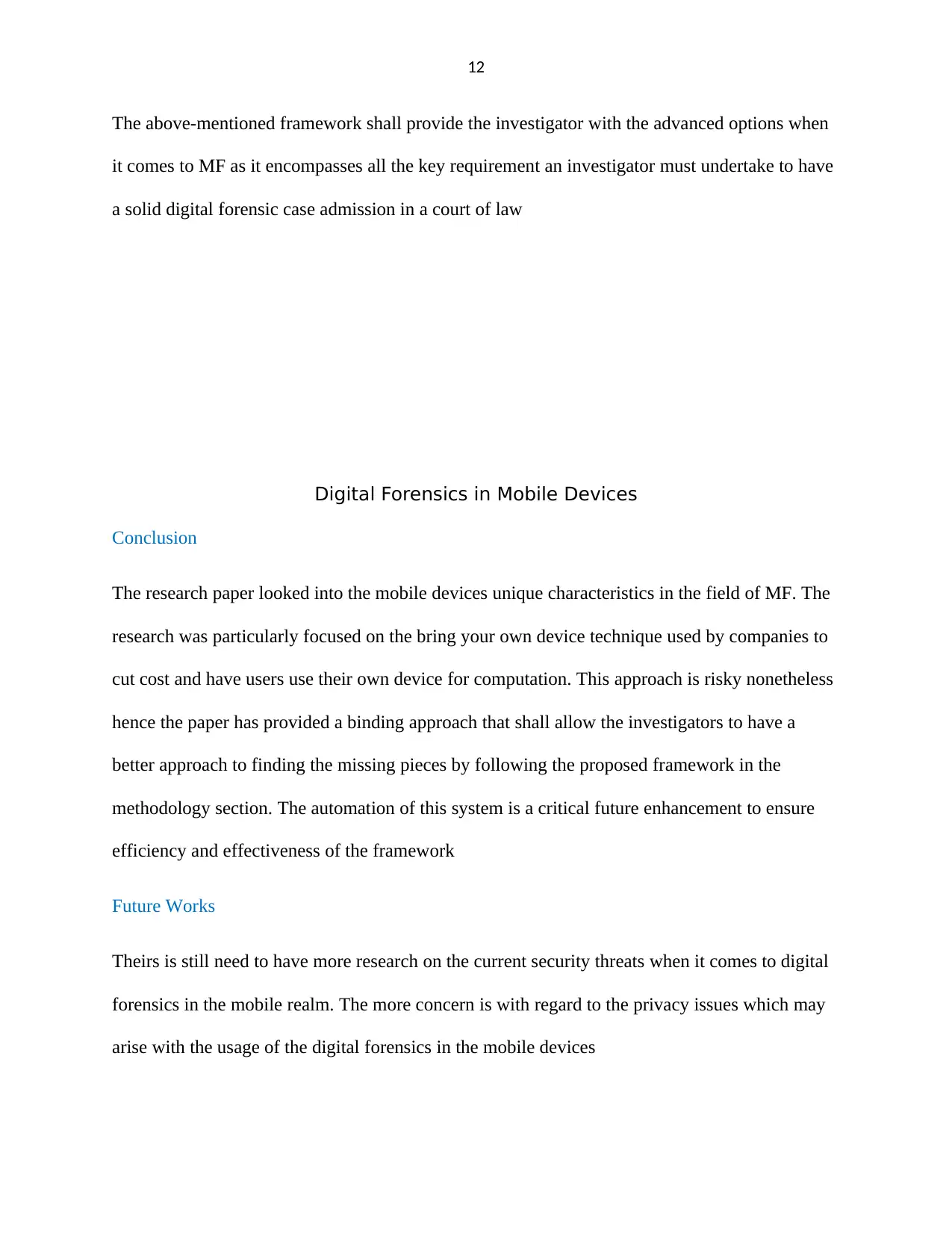
12
The above-mentioned framework shall provide the investigator with the advanced options when
it comes to MF as it encompasses all the key requirement an investigator must undertake to have
a solid digital forensic case admission in a court of law
Digital Forensics in Mobile Devices
Conclusion
The research paper looked into the mobile devices unique characteristics in the field of MF. The
research was particularly focused on the bring your own device technique used by companies to
cut cost and have users use their own device for computation. This approach is risky nonetheless
hence the paper has provided a binding approach that shall allow the investigators to have a
better approach to finding the missing pieces by following the proposed framework in the
methodology section. The automation of this system is a critical future enhancement to ensure
efficiency and effectiveness of the framework
Future Works
Theirs is still need to have more research on the current security threats when it comes to digital
forensics in the mobile realm. The more concern is with regard to the privacy issues which may
arise with the usage of the digital forensics in the mobile devices
The above-mentioned framework shall provide the investigator with the advanced options when
it comes to MF as it encompasses all the key requirement an investigator must undertake to have
a solid digital forensic case admission in a court of law
Digital Forensics in Mobile Devices
Conclusion
The research paper looked into the mobile devices unique characteristics in the field of MF. The
research was particularly focused on the bring your own device technique used by companies to
cut cost and have users use their own device for computation. This approach is risky nonetheless
hence the paper has provided a binding approach that shall allow the investigators to have a
better approach to finding the missing pieces by following the proposed framework in the
methodology section. The automation of this system is a critical future enhancement to ensure
efficiency and effectiveness of the framework
Future Works
Theirs is still need to have more research on the current security threats when it comes to digital
forensics in the mobile realm. The more concern is with regard to the privacy issues which may
arise with the usage of the digital forensics in the mobile devices
⊘ This is a preview!⊘
Do you want full access?
Subscribe today to unlock all pages.

Trusted by 1+ million students worldwide
1 out of 25
Related Documents
Your All-in-One AI-Powered Toolkit for Academic Success.
+13062052269
info@desklib.com
Available 24*7 on WhatsApp / Email
![[object Object]](/_next/static/media/star-bottom.7253800d.svg)
Unlock your academic potential
Copyright © 2020–2025 A2Z Services. All Rights Reserved. Developed and managed by ZUCOL.





